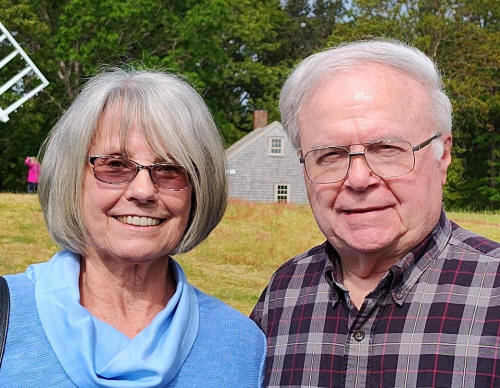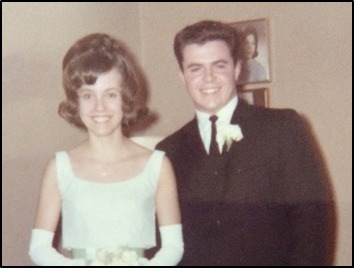

|
|
|
Secrets in an Irish Diary |

|
Available at Amazon.com
|
|||
|
Introduction |
|||
|
It’s their senior year in high school and the girl’s pipeline of new mysteries has run dry. In addition, they are beginning to worry about what will happen to their organization Les Mademoiselles after they graduate in June 1966. At her family’s annual reunion in the summer of 1965 Nancy picked up an interest in genealogy after talking with her grandfather’s older sister and her daughter. Her interest in researching her family’s history will show up various times as a minor interest while the girls continue to look for their next mystery.
|
|||
|
The Authors |
|||
 |
 |
||
|
After high school their lives followed different paths. They married, raised families and later retired. After changing circumstances in both their lives, they reconnected in the summer of 2018 and began exchanging emails. As the frequency of the emails increased and Michael learned more about Colette’s old neighborhood in Syracuse, NY, he realized that this was the part that was missing in a ghost story that he had been trying unsuccessfully to get off the ground. Early in 2019 he put together a story outline and sent it to Colette, asking her to sign on as his co-author. The collaboration has worked out well with Colette preventing Mike from making the stories too historically correct and Mike preventing Colette from making the girls behave in a too age appropriate manner. This is the third book to come out of this Les Mademoiselles collaboration. |
|||
|
Colette Smolinski Colette was born in Cornwall, Ontario, Canada. Her family came to the U.S. in the early ‘50s and settled in Syracuse, NY. In 1959 her family moved to Mattydale. Today she resides in Westvale, just west of Syracuse, NY. Michael McGraw Michael was born in Syracuse, NY and lived for a while in the university area. In September, 1949 his family moved to Mattydale, NY. Today he resides in Cedar Park, just north of Austin, TX. They both attended St. Margaret’s Catholic School in Mattydale and later North Syracuse Central High School.
|
|||
MattydaleHistory Mattydale is a small hamlet located in the town of Salina just over the northern edge of the First Ward of the city of Syracuse, NY. Starting in the early 1920s the farm lands that occupied the area had given way to residential developments, which grew rapidly. The name of Mattydale was derived from the name of the development that belonged to the area’s most famous citizen, the former Syracuse politician, Frank Matty. The names of the other approximately dozen developments, with the exception of Hinsdale Farms, faded and the name Mattydale took over as the name for the entire area. After a hiatus for the Depression and WW II, the growth continued with the Baby Boom which followed the war. During the 1950s new schools were popping up everywhere as the children of the boom entered school. By 1966, the residential growth was over as all of the available land in Mattydale had been used.
|
|||
The Evolution of the Old Wells StoryThe Well in the Woods The old well had been closed off by a wooden cover. While many thought its purpose was to prevent someone from falling into the well, others thought its purpose was to prevent “something” from climbing out of the well —such as a Hound from Hell. This was interesting but it wasn’t going to be enough to drive the whole story.
The Well on Leonard – it was really there, but what could we do with it. We certainly couldn’t have the girls starting digging in someone’s back yard.
The Well in the Field The story needed an old well in an open field. So, we let Mary Kirsch provide the source of the wells – the wells, four of them, had been built by the nursery folks, who had owned the land before the Kirsch family bought it in 1900. Mary remembered approximately where the old wells had been. The well that was located the furthest south was the one on Leonard and they ran in a straight line about parallel to Bear Trap Creek. The girls plotted out the approximate locations of the wells and discovered that one landed in the open field on the south side of Roxboro Jr. High School. This would be the one that the Onondaga Historical Association was excavating. Even though a skeleton was found at the bottom of the well this story line still didn’t seem to be strong even to drive the whole story. It was eventually tossed to Shirley and Emo to follow up on while the older girls went to Ireland.
The Thorp, Smith and Hanchett Nursey In 1860, the land that would later become the Kirsch farm was occupied by the Thorp, Smith and Hanchett Nurseries. This nursery employed a number of the newly arrived Irish as laborers. During the early 1950s the Kirsch family was still cultivating the land behind Nancy’s house on Kirsch drive by alternating wheat and potatoes. The field was split along an east-west line with one crop north of the line and the other to the south and the next year the crops were reversed. The potatoes were harvested mechanically and there were always some left behind. Neighbors living along the edge of the field would descend on the field after the harvesters had left and they would fill several bags with potatoes before they were finished. Along with the potatoes, these part-time harvesters would occasionally find the remnants of old clay pipes, which had been lost or discarded by those Irish nursery laborers from nearly a century earlier. Of course, our grandmother thought that these pipes had belonged to the wee folk and perhaps they weren’t even as old as everyone had thought. Perhaps, she said, the wee folk had been out in the field at night gathering up some potatoes for their families when they dropped the pipes. The suspected fairy fort, pointed out by our grandmother, was on the other side of the Military Tract lot line, lying on land that was once part of Benjamin Baum’s farm and then later the Michaels’ farm.
1860 map of Lot 18 in the town of Salina. Alanson Thorp, William Brown Smith, and John. C. Hanchett ran a large nursery bounded by Bear Trap Creek on the west; the north line of Military Lot #18 on the north; the Cicero plank road on the east; and on the south by a line extended from Molloy Road, passing through the Toll Gate house. The black square after the label “T S & H” at the intersection of the north line of Military Lot #18 and the Cicero plank road is the structure that probably became the Roselawn home of Benjamin Baum after he purchased it in 1866.
|
|||
Tipperary Hill
The boundaries of Tipperary Hill on the west side of Syracuse, NY today — according to the Tipperary Hill Neighborhood Association. This view is looking west, with north to the right. The Green Over the Red stop Light
Founded by Denis "Nibsy" Ryan in 1890 on Tipperary Hill, Syracuse, NY Denis Ryan had connections to Glown, Upperchurch, Co. Tipperary.
|
|||
In Ireland
Fairy Fort - Knockamena
This is a view of the Knockamena fairy fort looking west from the road on its east side.
In this aerial view the village of Upperchurch is situated in the lower right hand corner (southeast). The Knockamena fairy fort is the labeled elliptical structure located toward the top of the image.
|
|||
Bob Conan, Jr.
Robert Conan, Jr. was a real person but if he hadn’t existed we would have been forced to invent him. Nancy needed a mentor to guide her genealogy research and all of the girls needed advice on traveling in Ireland. Conan had genealogical research experience which was specific to the Upperchurch area which was of interest to Nancy since her family had emigrated from that area. Conan had been spending his summers in Ireland and became very familiar with the area and in general about things Irish. In October of 2010, I was reading a Wikipedia article on Tipperary Hill in Syracuse, NY. The article included a reference to the fact that a large number of persons who had settled in Pompey, NY had come from the Upperchurch area of Co. Tipperary in Ireland. That statement referenced a St. Patrick’s Day article in the Syracuse paper from 1977. I looked up the paper and it was a long article with many quotes, including the Upperchurch reference, by a Dr. Robert Conan who was a Chemistry professor at LeMoyne College in Syracuse. I wasn’t aware that anyone else had discovered the large concentration of former Upperchurch residents that had settled in the southern part of Onondaga County, at least not that early. More detail
The Challenge by Paul Conan, Jr. Dr. Robert James Conan was a unique individual with a brilliant mind and many passions. His lifelong friends in Syracuse N.Y. described him as a "Renaissance Man" but to me he was Uncle Bob. He was exceptional not only in his career as a Physical Chemistry professor and Chairman of the Chemistry Department at LeMoyne College, but also as a genealogist, pianist, and music composer. His collecting interests included ancient roman coins, historical signed documents, historical Irish books, Classical Music records, and Classical sheet music. Bob Conan's greatest passion was Irish genealogy, and he amassed a vast amount of information from his numerous trips to Ireland and his research in central New York, especially Pompey. Bob never married or had children, so when he died in 2002 his property passed to his brother (my father) Paul Sr., and then to my mother in 2013. Fortunately all of his genealogy research has been preserved and stored in dozens of boxes and 3-ring binders. To honor his life's work, my goal is to scan all his research and make it available to those who are interested. The challenge of The Conan Archival Project is the sheer scope and the time required to go through the boxes and organize everything, scan each page, and then combine the pages into specific subjects. The contents include letters from Irish priests in Upperchurch, County Tipperary and baptismal records. During his many trips to Ireland in the 1960s and 1970s, Bob became friends with several Upperchurch-area priests and was allowed rare access to transcribe church records from the old, fragile, hand written parish registers. These boxes and 3-ring binders also contain Irish maps showing where Irish relatives lived, letters from Irish people of County Tipperary, Bob's notes from his Irish record searches, family trees, family photos, cemetery records, newspaper clippings, scrapbooks, and even Bob's diaries. There are binders full of worksheets where Bob was trying to figure out family connections within Ireland in the 1800s. I also have Bob's two laptops from the 1990s which have not yet been opened or searched. This is a long-term project, but hopefully the results will be useful to those seeking information about their relatives in the Upperchurch-area as well as in Pompey, N.Y.
|
|||